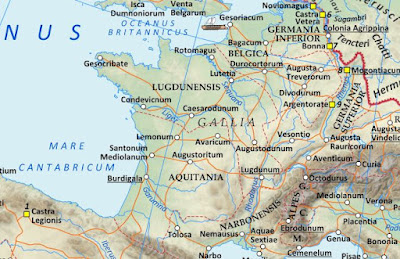Gallia Lugdunensis (which included Armorica)
Now Pescennius was on very friendly terms with Severus at the time that the latter was governor of the province of Lugdunensis.12 4 For he was sent to apprehend a body of deserters who were then ravaging Gaul in great numbers,13 5 and because he conducted himself in this task with credit, he gained the esteem of Severus, so much so, in fact, that the latter wrote to Commodus about him, and averred that he was a man indispensable to the state.
A few weeks ago, Professor Roger Tomlin and I had an involved discussion on whether ARMORICOS for the L. Artorius Castus memorial stone could work. He didn't think it could (and for several very good reasons). However, I had forgotten that a very long time ago I had taken the trouble of translating (poorly, using Google Translate) a couple of articles from the French scholar Picard. In Picard's view, there was more than sufficient evidence for an outright revolt of Armorica under Commodus. In re-reading the blog post, it occurred to me that if he is right, then, yes, we must allow ARMORICOS on the LAC inscription for the fragmentary ARM[...]S.
For those interested in the material supplied by Picard in support of the Armorican theory, see the following link:
I have sent this to Prof. Tomlin and asked him for his impression of the evidence.
Now, one of the primary reasons for selecting ARMENIOS for the LAC inscription is that 1) it fits very nicely 2) we know the British governor Statius Priscus was sent to lead the war against Armenia in the early 160s and 3) the foundation date of the province of Liburnia came not long after completion of the various Eastern campaigns. But, as is always the case with these sorts of things, LAC could have been granted his procuratorship after the execution of Perennis. And, indeed, of Cleander, Perennis' successor, Cassius Dio says
"So Cleander, raised to greatness by the favour of Fortune, bestowed and sold senatorships, military commands, procuratorships, governorships, and, in a word, everything."
It has long been proposed that LAC was granted his procuratorship as a reward for service. If we are looking at ARMORICOS for his stone, that may simply have been his successful role in aiding Pescennius Niger, governor of Gallia Lugdunensis, in clearing out the deserters from Gaul. Or, as has also been suggested before, it may have been given to him because of his role in the destruction of the Praetorian Prefect, Perennis.
The march of the 1500 British spearmen to Rome is still a difficult event to grapple with, historically. Some scholars have thought it a mere story. Others have quibbled about the word Dio uses to describe the leaders of the force (often rendered "lieutenants"): were they the embittered removed legates or were they merely subordinates? I think this last point is moot, as the force may well have had the legates with them, but as they were no longer legates we would not expect them to be referred to as such.
If this force were LAC's, we must account for why he would only have "ADVERSUS ARMORICOS" on his stone. We might presume that Castus had admirably performed his task as dux of British detachments in the Deserters' War. Then at that point the deposed legates took the force to Rome not only to be rewarded for their recent service, but to air their grievances to the Emperor. John S. McHugh, in his book THE EMPEROR COMMODUS: GOD AND GLADIATOR, has nicely laid out what these grievances might have entailed.
The idea that the British force had pursued Maternus, leader of the rebellion, to Rome is pretty far-fetched. Firstly, the whole take of Maternus in Rome, which comes from Herodian, is probably fiction. This is the consensus of Roman historians. Secondly, the terse account of the Deserters' War in the AUGUSTAN HISTORY confined the action to Gaul and makes it plain that the matter was concluded there and did not involve a pursuit of Maternus to the capital. It is much more likely that Maternus met his end in Gaul - and quite possibly in Armorica. If that were the case, then we can have Castus be the commander directly responsible for the rebel chieftain's inglorious end.
Again, all of the above simply shows that deciding between Armenia and Armorica for the LAC stone is problematic. I myself - personally - prefer Armorica. But not because I really care one way or the other who Castus fought in the context of Roman history. My bias runs forward a couple of centuries to the sub-Roman/early Medieval Arthur of Britain. My many years of research uncovered a significant strand of Welsh tradition that points strongly to Sawyl of Ribchester being Arthur's father. I am chary to forsake that tradition, as it appears to represent a genuine attempt to relate Arthur to a famous warrior-king of the North. There are a lot of excellent arguments in favor of the Sawyl = Uther equation. If I instead go with Armenia, and lose any connection with Ribchester via the Sarmatian presence in Britain, then Sawyl simply becomes an unviable candidate for Uther Pendragon.
For now, I will wait until Prof. Tomlin has had a chance to go through Picard and offer his opinion. Then it may be that I have to face this toughest of all decisions yet again!

No comments:
Post a Comment
Note: Only a member of this blog may post a comment.